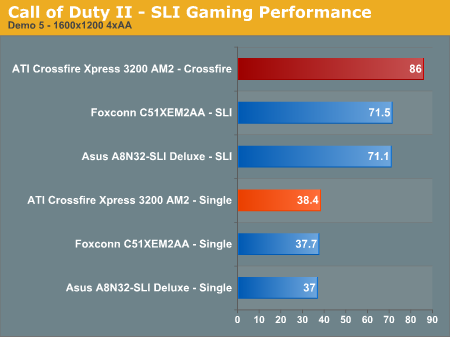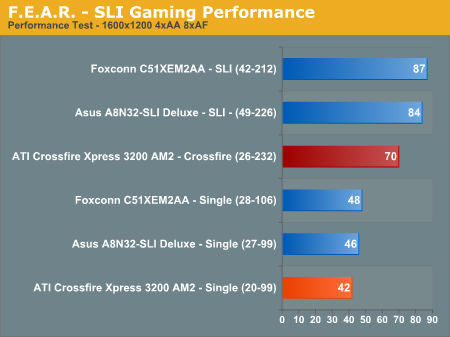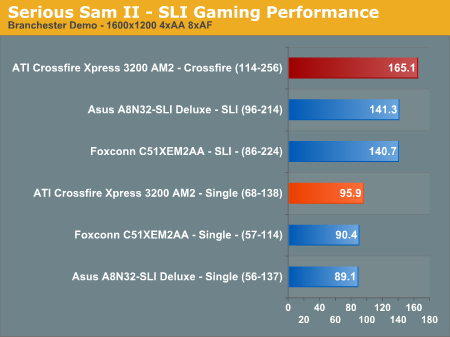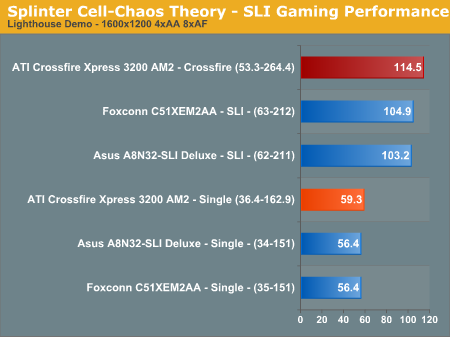CrossFire Xpress 3200: RD580 for AM2
by Wesley Fink on June 1, 2006 12:05 AM EST- Posted in
- Motherboards
CrossFire Gaming Performance
Both major players in the Video Market now have flagship Dual X16 solutions. SLI and CrossFire are about gaming, so CrossFire tests were confined to gaming benchmarks, and the test suite is heavily slanted to recent and popular titles where SLI and CrossFire make the biggest difference. All CrossFire testing was at 1600x1200, 4X AA, and 8X AF. Tests were also run with a single X1900 XT at this same resolution. The single video high-res results on the ATI AM2 are in Orange and the CrossFire results are in Red.





You might think you are looking at results from different video cards in CrossFire/SLI performance. Here leads are larger and positions are often switched from results at standard resolution without the eye candy. ATI CrossFire is the clear winner in Serous Sam 2, COD2, and Splinter Cell: Chaos Theory, while NVIDIA SLI owns Half Life 2 and F.E.A.R. We suspect part of these multi-GPU results revolve around which card has the best optimized drivers available.
We complained about ATI's CrossFire interface in our last two CrossFire reviews, and it still remains clumsy and anything but intuitive. To use CrossFire you MUST install Catalyst Control Center. If CCC is not installed CrossFire will not work. Since many users don't install CCC this is anything but an intuitive solution for CrossFire. Once installed, you must go into CCC, select the CrossFire tab and enable the feature. This is a MANUAL procedure - there is no warning at all that you have a CrossFire capable board or that you have to go into CCC to enable CrossFire. NVIDIA warns you that an SLI-capable system is installed and prompts you to enable SLI. There is no warning at all with ATI. The only clue you will have that CrossFire is NOT turned in is the poor performance results. THEN you start looking for what's wrong. ATI really needs to fix this issue. CrossFire performance is very good, but it would be much nicer if ATI made it easier to turn on CrossFire.
Both major players in the Video Market now have flagship Dual X16 solutions. SLI and CrossFire are about gaming, so CrossFire tests were confined to gaming benchmarks, and the test suite is heavily slanted to recent and popular titles where SLI and CrossFire make the biggest difference. All CrossFire testing was at 1600x1200, 4X AA, and 8X AF. Tests were also run with a single X1900 XT at this same resolution. The single video high-res results on the ATI AM2 are in Orange and the CrossFire results are in Red.





You might think you are looking at results from different video cards in CrossFire/SLI performance. Here leads are larger and positions are often switched from results at standard resolution without the eye candy. ATI CrossFire is the clear winner in Serous Sam 2, COD2, and Splinter Cell: Chaos Theory, while NVIDIA SLI owns Half Life 2 and F.E.A.R. We suspect part of these multi-GPU results revolve around which card has the best optimized drivers available.
We complained about ATI's CrossFire interface in our last two CrossFire reviews, and it still remains clumsy and anything but intuitive. To use CrossFire you MUST install Catalyst Control Center. If CCC is not installed CrossFire will not work. Since many users don't install CCC this is anything but an intuitive solution for CrossFire. Once installed, you must go into CCC, select the CrossFire tab and enable the feature. This is a MANUAL procedure - there is no warning at all that you have a CrossFire capable board or that you have to go into CCC to enable CrossFire. NVIDIA warns you that an SLI-capable system is installed and prompts you to enable SLI. There is no warning at all with ATI. The only clue you will have that CrossFire is NOT turned in is the poor performance results. THEN you start looking for what's wrong. ATI really needs to fix this issue. CrossFire performance is very good, but it would be much nicer if ATI made it easier to turn on CrossFire.










71 Comments
View All Comments
LoneWolf15 - Thursday, June 1, 2006 - link
Not that anyone will necessarily do so, but will RD580 support the building of Socket 939 boards as well?JarredWalton - Thursday, June 1, 2006 - link
RD580 socket 939 boards have already been made -- well, at least one of them has been made. http://www.anandtech.com/mb/showdoc.aspx?i=2752">DFI CFX3200-DR It is doubtful that we will see many more socket 939 boards using the chipset, since AM2 is basically going to replace socket 939 as fast as AMD can make it happen.LoneWolf15 - Thursday, June 1, 2006 - link
On Page 1, the table for the RD580 shows (8) SATA2 ports and dual-gig ethernet. The board specs on page two on the other hand, show 4 SATA2 ports, and single gig ethernet, but only if a PHY (i.e., Marvel or someone else) is used.Apparently ATI has added 4 additional SATA ports via Silicon image on the reference board; but I don't call that a feature of RD580. What am I missing here? The table on page 1 seems to contradict what is listed on page 2.
Wesley Fink - Thursday, June 1, 2006 - link
We agree with you. The chipset has 4 SATA2 ports and the extra 4 ports come from 3132 Silicon Image controllers. I will try to edit the image.LoneWolf15 - Friday, June 2, 2006 - link
Thanks. Also, what about FireWire? I think your article said that neither nVidia nor ATI has native Firewire (additional VIA/other vendor chipset required), but RD480 and RD580 are listed on your opening table as having 1/2 Firewire ports respectively.Stele - Friday, June 2, 2006 - link
I think the opening table is just a platform chart that divides the target markets of each chipset. On the first column is the target price range of a certain motherboard range. The second column identifies which chipset is meant to cover that particular range. The third column then explains the primary target market for that particular range. Lastly the right-most column briefly describes the features such a motherboard in that particular range should have.Wesley Fink - Friday, June 2, 2006 - link
You are correct, Stele. With that said I now think a better way to handle this and remove confusion is to go back to the original chart and clarify that this is recommendations in the text. Thanks.Stele - Friday, June 2, 2006 - link
Oh you're welcome. Looks like our replies to him were posted at the same time :PYes I think that's a great idea, otherwise after all the editing you're not going to have very much on that chart anymore! Soon we'll have people saying "$250 for a chipset? Then what's the motherboard going to cost??" ;)
Wesley Fink - Friday, June 2, 2006 - link
The feature chart is from ATI literature and was a listing of recommended configurations for various market segments. I have changed the SATA and Gigabit LAN and will remove the Firewire, since it is not chipset specific for either nVidia or ATI. There is an excellent VIA Firewire controller on the Reference board, though we would rather see Firewire 800 which is very fast but disappearing from new board introductions.Stele - Friday, June 2, 2006 - link
Probably because of
1) poor OS support - even Microsoft noted that Vista would not support 1394b at launch
2) poor device support - the majority of appliances and peripherals seem to be quite happy at 1394a with no signs of an imminent and/or major switchover to 1394b
so motherboard manufacturers probably thought "what the heck" and decided to keep costs low for now by sticking to the 1394a controllers, which are likely cheaper than their 1394b counterparts. Furthermore, the 1394a solutions are tried and tested, hence they also avoid unpleasant design surprises that may require time and effort to redesign around... resources which could be better used elsewhere for now.